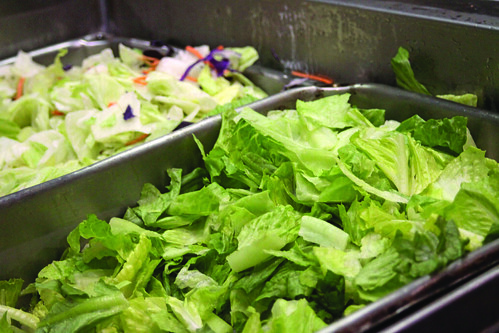With the variety of not-so-healthy foods on Main Campus, healthier green options are valuable.
An average college student’s diet, usually consisting of foods like greasy, late-night pizza, General Tso’s chicken and Philly cheesesteaks, can often use a shot of greens.
Loaded with antioxidants, fiber and phytochemicals, greens are not just for Popeye.
Dark, leafy greens, such as kale, spinach, Swiss chard and collard greens, are some of the most nutritious items in the vegetable kingdom – and yes, they can be tasty, too.
These foods can greatly enhance health, adding an assortment of nutrients to one’s diet.

“There is research to support that consuming a variety of greens, including kale, Swiss chard, spinach and mustard greens, can lead to a decreased risk of diabetes and heart disease,” said Nicole Patience, a registered dietician at Temple.
They’re also rich in folate and vitamins A, C, E and K, Patience said, which all help fend off cancerous free radicals.
“Greens can also support weight management, as they contain a healthy amount of fiber to help us feel full with fewer calories,” Patience said.
If you aren’t keen on gulping down spinach straight from the can, check out these tips on how to include greens into your diet.
Style Up Your Smoothie
If you haven’t been to a juice joint lately, you may be missing one of the latest health trends – blending vegetables into smoothies. It may sound insane, but it’s a tasty way to start the day right.
Get your mind off V8, and instead, think sweet green fusion. Blend half an apple, eight to 10 strawberries and a few leaves of a green of your choice. Once the mixture is smooth, pour into a glass and enjoy. Try experimenting with different greens and fruits: I suggest a few blueberries or half a banana.
Super-Spinach
Your Super-Sized Salad
The next time you’re at the Student Center, once you’ve weaved your way through the daily mob to get to the salad bar, opt for the larger available container, and fill at least half with spinach.
“Spinach is a great source of iron, especially when fruits or vegetables that have vitamin C, such as green peppers, broccoli, strawberries or orange segments, are added to help with iron absorption,” Patience said.
Dress it up with some colorful veggies, oil, vinegar, salt and pepper. If you do decide to mix the spinach with lettuce, skip the iceberg in favor of leafy green romaine.
Be Sneaky
Now that you’re no longer a kid, you don’t have your parents to look over you and sneak vegetables into your favorite meals. It’s your turn to be sneaky and disguise those veggies into your everyday cooking.
Try adding a layer of greens to lasagna. Chop up a few leaves of precooked greens, and toss them into spaghetti, omelets, burritos, rice dishes and so on. Even a small amount can be beneficial to your health.
Chow Down Chinatown Style
Chinese restaurants can offer a lot of vegetable options. Next time you’re about to order your usual pork fried rice with an egg roll, check out the healthier options on the menu, such as sautéed snow pea leaves.
Most Chinese foods can be easily prepared at home, and greens are the perfect candidate for doing so. A variety of Asian sauces can be purchased at the supermarket and are great for jazzing up greens. Pick one up, and sauté your choice green in it until tender, or substitute the sauce with garlic and olive oil. Both can help cut the bitterness of the greens. Add some shrimp and pair it with rice, and you have a full Chinese meal all your own.
Autumn is a prime season to purchase locally grown greens. Check out one of Philly’s many farmers markets, where you can be sure to find a variety of greens that will help you put your new skills to work.
Grace Dickinson can be reached at grace.dickinson@temple.edu.



Be the first to comment